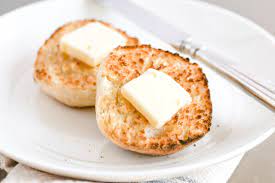In a small microwave-safe bowl, mix the water and sugar. Heat in microwave to a temperature of between 110℉ - 115℉. This should take less than a minute and it’s very important to use a thermometer to get the correct temperature.
Dissolve yeast in milk mixture and set aside for 7 minutes to proof. It should “bloom” or form a foam on top.
In the meantime, add 1½ cups flour and salt to the bowl of a stand mixer fitted with the flat beater paddle and whisk together with a fork.
When yeast is proofed, add eggs, vinegar and yeast mixture to the flour mixture. Blend with the mixer until smooth.
Cover the bowl and let it sit for 45 minutes. Because of the thinness of the batter, there will not be much change in the batter, although it should develop some bubbles.
Add the remaining cup of flour and beat for 8-10 minutes until the dough clears the side of the bowl and is shiny and elastic.
Place a pastry mat or sprinkle some flour on your work surface. Pound the butter with the side of a rolling pin until it forms a cohesive rectangle about ¼“ thick. Fold the butter over as you’re working it so it will become pliable without becoming too warm or soft.
Add the butter to the dough and beat it until it’s fully incorporated.
Cover the dough and let it rise for 1 hour. It will still be very soft at this point. Turn it out onto your pastry mat or lightly floured work surface and use a pastry knife to turn it over several times.
Place the dough in a greased bowl and cover it. Refrigerate dough for a minimum of 4 hours or up to 16 hours.
Place the dough into a loaf pan or form it into a more traditional shape, such as a round or braided loaf. If you choose to shape the dough, work quickly so the dough doesn’t become warm and sticky. Place shaped dough into a brioche pan or round casserole dish.
Allow to rise for 2½ to 3 hours or until it’s doubled in size and crowning over the top of the pan.
Preheat oven to 375℉. If a shiny crust is desired, brush with some egg wash.
Bake for 45-50 minutes until it is golden brown and has an internal temperature of 190℉.
Remove the brioche from the oven and allow it to cool for 10 minutes before turning it out of the pan. Allow bread to cool completely before slicing it.
Hack: Pastry knives (also referred to as bowl scrapers or pastry bench scrappers) can be stainless steel or plastic and cost as little as $1.00. If you don’t have one on hand, you can use a sturdy spatula, cake/pie server or butter knife. If you must know the truth, I use a plastic drywall mudding tool as a pastry knife.
Hack: Use flour sparingly when pounding/kneading. Too much flour may cause your finished product to be dry.
Hack: For better rising, put the covered dough in a sunny spot in your house. I’m not sure this is necessary in warmer climates but it sure helps here in cold New England!
Hack: On the final rise, gauge the readiness of the dough by pressing your finger gently on the top. If it bounces right back, it’s not proofed enough. Your fingerprint should remain after you take your finger away, however, if your dough falls to any degree after removing your finger, it’s over-proofed and will probably fall in the oven.
Hack: Bread can be sliced and then frozen or refrigerated for longer storage. You can “refresh” the bread by warming it briefly in the microwave or toasting it before use.
Hack: If the bread stales before you’ve finished eating it, run it between your fingers (or use a food processor) to turn it into bread crumbs. Seal it in a bag or container and store it in the freezer for future use.
Hack: This recipe can be turned into sandwich rolls if preferred. After the first rise, separate the dough into 8 pieces and form it into rolls. Place each roll into a 5” pastry circle and allow to rise until double, about 30 minutes. Bake for about 20 minutes.










